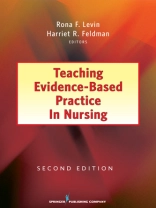Awarded second place in the 2013 AJN Book of the Year Awards in the Nursing Education/Continuing Education category
This AJN award-winning text is the only book to teach evidence-based practice (EBP) content grounded in a tested philosophy of teaching and learning. It provides the tools, perspective and context for health educators and practitioners to implement evidence-based care practices and evaluate their efficacy.
Reflecting four years of successful experiences in helping academic agencies understand and implement EBP, this new edition has been reorganized to include updated information and five new chapters. It stresses the importance of mentorship in creating EBP and illustrates how mentorship can be designed and implemented to promote EBP. The text clarifies three principal values:
Teaching Evidence-Based Practice in Nursing will be of value to clinical and academic educators, educational and clinical administrators, unit managers, students attending CE programs, and students in nursing education graduate programs.
Key Features:- Revises and expands upon AJN Book of the Year Award first edition
- Reflects knowledge gained from four years of successful experiences in teaching and learning EBP since publication of first edition
- Provides comprehensive and innovative strategies for mentoring and teaching EBP in education and practice scenarios
- Describes how to implement EBP at undergraduate levels, for second career students, and in continuing education
Table of Content
‘
Biographies for RFL and HRF
Contributing Authors
Acknowledgements
Foreword
Preface
Introduction to Part I
Part 1: Mentorship: An Essential Component of Creating EBP Champions
1: Defining Mentorship for EBP
2: Mentoring Clinical Champions
3: Mentoring Faculty for Evidence-Based Practice: Letís Work Together
4: Mentoring Preceptors for EBP
Introduction to Part II
Part 2: Evidence-Based Teaching Practices: Let’s Practice What We Preach
5: Describing the Practice Area for Improvement
6: Involving Stakeholders in Determining the Clinical Problem: A Learning Activity
7: Teaching Students to Formulate Clinical Questions: Tell Me Your Problems and Then Read My Lips
8: Integration of Critical Thinking and EBP into ìRoutineî Practice
9: Searching the Sea of Evidence
10: Synthesizing Evidence and Separating Apples from Oranges
11: Evaluating Clinical Practice Guidelines
12 Strategies for Teaching Statistics
13: Teaching Treatment Effectiveness Formulas
14: Determining Sensitivity and Specificity of Assessment Tools for Formulating ìAt Riskî Nursing Diagnoses
15: Teaching Sensitivity and Specificity for Medical and NP Practice
16: Conducting a Gap Analysis
17: Outcome Evaluation for Programs Teaching EBP
Introduction to Part III
Part 3: Strategies for Creating an Academic Culture for EBP
18: Refocusing the Academic Culture
19: Teaching EBP throughout an Undergraduate Curriculum
20: ”Second” Thoughts on Teaching EBP
21: Integrating EBP in Doctoral Education: NYU
22: Integrating EBP into DNP Education: The Pace Experience
Introduction to Part IV
Part 4: Strategies for Creating a Practice Culture for EBP
23: Implementing an EBP Council in a Hospital Setting: NWH
24: Establishing a Questioning Practice Community
25: Implementing an EBPI Improvement Program in a Community Health Agency: The Visiting Nurse Service of New York Experience (Part I)
26: Implementing an EBPI Improvement Program in a Community Health Agency: The Visiting Nurse Service of New York Experience (Part II)
Introduction to Part V
Part 5: Strategies for Crafting Creative Collaborations for EBP
27: Establishing an EBP Alliance: Come Together Right Now
28: Global Partnerships for EBP: Crossing State and National Boundaries
Glossary
Annotated Bibliography
‘About the author
Harriet R. Feldman, Ph D, RN, FAAN, is Dean, Lienhard School of Nursing, Pace University.












